European Logistics 2013: Big Challenges, Bigger Expectations

The Euro crisis is still hampering the European logistics and transportation landscape, however, measures are currently underway to stabilize the region, including plans for a closer partnership with the U.S.
Today, the U.S. and the European Union (EU) together represent nearly 50 percent of the global economy—although they only represent 11.8 percent of the global population.
President Obama announced in his State of the Union speech earlier this year that talks on a comprehensive Transatlantic Trade and Investment Partnership (TTIP) with the EU will be in sharp focus as the year’s political agenda rolls on.
TTIP, the biggest bilateral trade agreement ever negotiated, is aimed at cutting tariffs and eliminating trade barriers between the world’s two largest economies. The first round of TTIP negotiations took place in July and the second round will follow in October 2013—the goal is to reach an agreement within a few years.
Expectations are high on both sides. The agreement would give U.S. companies greater access to the world’s largest economy, increasing the $458 billion in goods and private services the U.S. exported in 2012 to the EU, its largest export market.
According to a study by the London based Centre for Economic Policy Research, TTIP could bring a potential economic upswing of around 95 billion euros ($127 billion) for the U.S. economy and around 119 billion euros ($159 billion) for the EU.
Even if ports, carriers, and third-party logistics providers (3PLs) share the policymakers’ hopes for the future, the current situation is more mixed.
Company results for the first half of 2013 show a blend of highs and lows for many of the major actors in the EU logistics and shipping sector. However, the EU Commission, trade associations, and companies are not waiting for future policies, but say that they’ve already been taking initiatives to boost business on both sides of the Atlantic. These measures range from policy decisions through investments and new business strategies.
EU Commission proposes “Blue Belt”
To increase trade volumes for EU and non-EU goods within Europe, Siim Kallas, vice president of the EU Commission, just started the “Blue Belt” initiative to ease customs formalities for short sea shipping. “Blue Belt” refers to the blue in the EU flag and is meant to tie the EU states more closely together—it will also make shipping to, from, and within the EU more efficient by eliminating red tape in customs.
Today, EU and non-EU goods are not separated and every piece of cargo must undergo time and cost intensive customs procedures. With the implementation of “Blue Belt,” only non-EU goods on board ships calling at both EU and non-EU ports will have to go through European customs clearance. This will provide cost and time advantages that benefit U.S. companies operating in various EU and non-EU states, as well as the Europeans.
It is expected that the Blue Belt measures, that are based on the following two proposals, will be put in place by 2015:
Easing customs formalities for intra-EU shipping: Shipping companies, using a regular route within the EU and transporting mainly EU goods, can already benefit from lighter customs procedures under the Regular Shipping Services procedures. New proposals, submitted by the Commission in June 2013, will upgrade this Regular Shipping Services to make the procedures shorter and more flexible. The consultation period for Member States will be shortened to 15, from 45 days, and companies will be able to apply in advance for an authorization for Member States where they may want to do business.
Easing customs formalities for ships that call in non-EU ports: Almost 90 percent of ships carry both EU and non-EU goods and stop frequently at EU and non-EU ports. For these ships, the Commission is proposing to significantly improve customs procedures by putting in place a system that can distinguish between EU goods on board that should be swiftly discharged and the non-EU goods on board that must go through the appropriate customs procedures.
For this purpose, the Commission will, before the end of the year, propose to create a harmonized electronic cargo declaration. This new “eManifest” will allow the shipping company to provide in all manifests—intra-EU and extra-EU—information on the status of goods to customs officials.
European expansion in the U.S. market
Despite the Euro crisis and the current weakness in the European economy, business for European logistics providers during the first half of the year 2013 was not as bad as expected. The leading players continued to expand their networks and services.
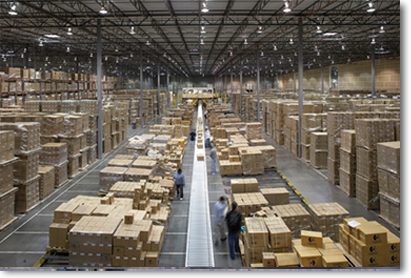
The Swiss-based Kuehne + Nagel Group reported positive half-year results in 2013. Compared to the previous year’s second quarter, the Kuehne + Nagel Group achieved an 8.1 percent increase in earnings before tax.
During the first six months of 2013, turnover increased 3.3 percent to 10,394 million Swiss francs and gross profit by 2.6 percent to 3,112 million Swiss francs.
In April, the logistics provider expanded its operations in the Southeastern U.S. and opened a new office in Mobile, Ala., to offer logistics solutions for aerospace companies as well as the oil and gas and marine sectors.
Deutsche Post DHL is also sticking to its successful path. During the second quarter of 2013, revenues produced by the group totaled 13.6 billion Euros between April and June. The slight 0.6 percent dip compared with the same period last year was solely the result of negative exchange rates and other inorganic effects, according to the mail and logistics company.
During the second quarter, consolidated net profit climbed from 196 million euros in 2012 to 422 million euros in 2013 due in part to one time effects. Supporting its performance in the Americas, DHL inaugurated its expanded $105 million Americas hub at the Cincinnati/Northern Kentucky (CVG) Airport to meet the growing international shipping demand of large multinational corporations as well as small business customers.
In the meantime, stable revenues and lower profits have been reported by the German rail and logistics group Deutsche Bahn (DB). While revenues for the first six months remained fairly stable at 19.37 billion euros (-0.6 percent), earnings before interest and taxes fell notably by 22.9 percent.
The number of shipments carried by the DB Schenker Logistics business unit in the European land transport sector decreased by 1 percent. The volume of airfreight shipments fell by 2 percent and ocean freight shipments dropped by 1.6 percent. Contract logistics business developed positively, as revenues rose 6.9 percent in the first half of 2013.
The French SNCF Group revenue totaled 16 billion euros in the first half of 2013, on par with the first half of 2012 at constant scope of consolidation and exchange rates, and reached 1.29 billion euros. SNCF Geodis, the freight transport and logistics business, dropped 2.9 percent in the French and European markets hit by the recession.
EU air cargo ups and downs
Europe’s air cargo market remained under pressure during the first half of this year, although there were some signs of improvement.
According to the recent outlook report by the International Air Transport Association (IATA), European airlines are expected to report profits of $1.6 billion in 2013, double the previous projection. Consolidation on the North Atlantic market and within Europe is helping to improve financial performance. Based on the airfreight statistics in June, volumes carried out by European airlines improved by 2.6 percent over a year ago.
However, given that the Eurozone economy remains in recession, the improvement in airfreight volumes will rest on a fragile ground, IATA says. Europe’s carriers are also worried that the Single European Sky (SES) initiative is not moving fast enough. This initiative of the EU Commission provides a legislative framework to meet future safety, capacity, and efficiency needs at a European rather than at a national level.
The idea is to organize air traffic control according to traffic flows instead of national borders. The SES 2+ package was introduced by the Commission in June to increase the economic, financial, and environmental performance of the system. However, it provoked resistance and strikes in European member countries.
“A lot of states are still not willing to give up national competences and national air traffic control,” says Dr. Christoph Franz, chairman and CEO of the Lufthansa Group. “Every intra-EU flight is 50km longer than necessary, which results in $6.53 billion in additional costs every year. And don’t forget the avoidable CO2 emissions, which add up to 50 million metric tons every year. So the arguments about why we need SES now are extremely convincing.”
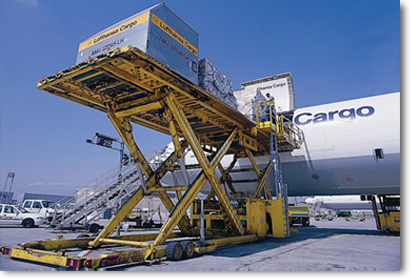
This year is shaping up to be another challenging year for Europe’s leading air cargo carriers. For the first half of 2013, Lufthansa Cargo experienced a 3.5 percent decline in freight and mail traffic to 839,000 metric tons.
“There are clear signs of the weak performance of the global economy in the level of demand,” says Lufthansa Cargo CEO and chairman of the executive board Karl Ulrich Garnadt in respect of the half-year figures. At the same time, he announced that there would be further investment in the quality of the freighter network. For example, new routes to the U.S., South America, and China are planned for the winter schedule.
Air France-KLM also reported a decline in cargo business for the first half of 2013. The group reduced capacity by 4.2 percent, but traffic fell sharply (-6.3 percent), resulting in a 1.4 point fall in the load factor to 63 percent.
Commenting on the business globally, Alexandre de Juniac, Air France-KLM chairman and CEO, says that the group’s strategic business plan “Transform 2015,” which is aimed at reducing unit costs by 10 percent, restoring profitability and strengthening the balance sheet, is fully on track. Nevertheless, revenues remain below target and the turnaround is taking longer than expected.
Ports set up LNG infrastructure
More stringent International Maritime Organization (IMO) regulations to reduce sulfur dioxide emissions of ships are also going ahead. Beginning January 1, 2015, in the special areas (SECA), which are the Baltic Sea, the North Sea, and the English Channel, the sulfur content of fuel will be lowered to 0.1 percent.
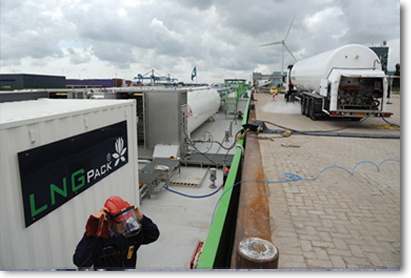
Ports and shipping companies in Europe are responding. There are several European port initiatives supported by EU funds to provide an appropriate infrastructure for liquefied natural gas (LNG) and onshore power supply.
In July 2013, Rotterdam and Gothenburg announced that they received 35 million euros from the European Union to set up LNG bunkering facilities by 2015.
“A major benefit of this collaboration is that we can work together and send a very clear signal to the market that LNG will be available at the largest port in Europe and the largest port in the Nordic region,” says Lars Gustafsson, president of Swedegas. Starting July 1, the Port of Rotterdam now officially offers LNG bunkering for inland shipping vessels in the Seinehaven in Rotterdam Botlek.
The location of the first LNG bunkering terminal in the port will be announced later this year. Port of Antwerp also moved forward to facilitate and encourage the use of LNG as a shipping fuel and has teamed up with ship classification bureau Det Norske Veritas (DNV) to ensure the safe and efficient bunkering of LNG by seagoing ships and barges in its port by 2015.
Hamburg Süd takes steps for sustainability
Leading European carriers like Hamburg Süd are going to be well prepared for LNG and onshore power supply. According to Dr. Ottmar Gast, Chairman of the Executive Board of Hamburg Süd, LNG-powered containerships are on the drawing board, but a full-fledged launch is still a number of years away.
Infrastructure issues as well as technical challenges still remain. Two LNG-powered container ships are on order to be built in the U.S., but these are designed to be operated in domestic trade with a limited number of port calls.
Concerning shore-based power, Hamburg Süd, along with other ocean carriers, is in the middle of planning for the implementation of the new California Air Resource Board rules, which require ships to be supplied with shore power while in California ports. A team of experts is working on how to comply best with these new requirements, which will come into force on January 1, 2014. Hamburg Süd operates four liner services to and from California, with more than 30 monthly ship calls.
The carrier has been in the forefront of environmental protection initiatives and has won numerous awards from both the Port of Los Angeles and Port of Long Beach for actively managing the reduction in ships’ emissions. Looking ahead to the economic outlook for 2014, Dr. Gast says that U.S. seaborne exports in our major trade lanes have slowed, particularly to Brazil. “However, we are responding by optimizing our network and shifting capacity to areas where demand is still strong,” says Dr. Gast. “For 2014 we see the U.S. Gulf as an area of opportunity where U.S. chemical manufacturers have invested in major production facilities to take advantage of lower U.S. energy costs.”
Prospects for North European trade
According to the Global Port Tracker for Northern Europe that was released by Hackett Associates and the Institute of Shipping and Logistics (ISL) in August, the prospects for trade in this region, that includes the North Range ports of Rotterdam, Antwerp, Hamburg, Bremen/Bremerhaven, Zeebrugge, and Le Havre, are not looking as optimistic in 2013 as had been predicted.
While Europe’s overall import volume is estimated to increase by 3.9 percent in 2013, Northern Europe’s import volume is expected to fall 8.9 percent to 12.2 million twenty-foot equivalent units (TEU). The forecast for exports projects a 4.1 percent growth for Europe as a whole, with Northern Europe decreasing by 2.3 percent to 10.59 million TEU. Ben Hackett of Hackett Associates points out that the slowdown in China’s growth has as strong an impact on export trade as the recession, which he believes will continue.
With regard to the near future, Hackett cautions: “Don’t expect the Northern European economies to recover quickly from their economic doldrums.”
Booming Baltic region
In terms of intra-European traffic, an increase of 7.8 percent to 9.7 million TEU in 2015 has been forecast by the Dutch consultancy Dynamar, with the highest growth being predicted for the Baltic region. Although year-over-year growth rates throughout European ports that handle intra-Northern European services was relatively modest, Baltic ports reported a growth volume of more than 9 percent for the same period.
Referring to the Baltic Container Yearbook 2013, published by Baltic Press, container turnover in the Baltic Sea ports increased in 2012 to almost 9.5 million TEU in total. About three million TEU, one third, was handled in the three largest Russian Baltic ports St. Petersburg, Kalingrad, and Ust-Luga, followed by the three main Polish ports Gdansk, Gdynia, and Szczecin-Swinoujscie with almost 1.7 million TEU in total.
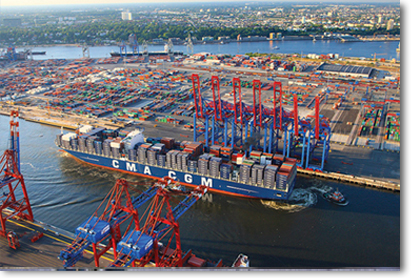
While the world economy slumped and sea freight rates collapsed, shipping lines reacted with a number of cost-saving measures to improve their profitability. This apparently has also made room for them to test the market by offering direct calls with larger vessels on the Baltic, taking full advantage of utilizing larger tonnage.
Furthermore, Baltic countries such as Poland have been less affected by the worldwide economic slump. They have the market potential to make the calls cost effective. Therefore, an increasing number of international carriers such as Maersk and CMA CGM are now offering direct ocean vessel calls to the Baltic Sea ports, thus contributing to the growing Baltic trade volumes.
Port of Rotterdam completes Maasvlakte 2
During the first half of 2013, the Port of Rotterdam successfully completed construction of the port extension project Maasvlakte 2, which increased the port’s size by 20 percent. This new port area is accessible by road, rail, and water, and is planned to include industrial parks as well as modern terminals. Despite the scope of the project, it will cost 150 million euros less than initially planned.
Various infrastructure projects are also on schedule at the port. The APM Terminals and RWG container terminals now in construction are planned to be operational by the end of next year.
Through all of this news, Rotterdam has doubled its container capacity by opening the new port area and is now eager to fill it up. Throughout the first half of 2013, the number of containers handled by the port increased slightly, up 1 percent, while the tonnage decreased by 2 percent due to the still sluggish economy in Europe.
Feeder transport went down by 6 percent, as feeder connections between the Baltic States and Rotterdam have in part been shifted to ports in Northern Germany. Overcapacity in container shipping is another reason for the decline, say port officials, because ship owners cut costs by making more direct port calls than in the past.
Liquid bulk drives Port of Antwerp’s growth
During the first six months of this year, the Port of Antwerp handled 95,662,759 metric tons of freight, an increase of 2.0 percent compared to the same period in 2012. While container volumes fell slightly by 1.7 percent in terms of TEU, and 3.7 percent by tons, liquid bulk showed strong growth, up 33 percent, mainly driven by an increase in petroleum derivatives.
The Antwerp oil and chemical sector has benefited in recent years from a steady stream of investments in storage capacity for oil products, chemicals, and gases. During the past ten years, the volume of oceangoing cargo for tank storage companies rose 151 percent, and the number of tank storage terminals increased 40 percent to a total of 15.
U.S. companies such as Ineos Oxide, FRX Polymers, Ferro, Praxair, and ExxonMobil are investing steadily in their Antwerp sites. “In combination with the investments recently announced, these half-year figures lead us to be cautiously optimistic,” said Port Authority CEO Eddy Bruyninckx.
Port of Amsterdam corporatized
On April 1, 2013, the Port of Amsterdam became a public enterprise. The Dutch port will move forward as a limited liability company of which the City of Amsterdam is the main shareholder.
Port of Amsterdam is the fourth largest port in Western Europe and a main hub for transhipments and handling energy products. The North Sea Canal Area tranships almost 100 million tons of goods annually, of which 77 million tons are handled in the port.
One of the first initiatives to boost business under the new corporate structure was the port’s participation in an economic mission to Texas in July initiated by the Dutch Prime Minister as well as the Infrastructure and Environment Minister along with their Flemish counterparts.
More than 90 Dutch and Flemish companies made the trip that was designed to focus on port development in the energy and petrochemical sectors in the U.S. and discover new opportunities for the ports of Amsterdam, Rotterdam, and Antwerp. The main goal was to profile the Netherlands and Flanders delta area as an integrated economic region and to establish contacts between Dutch, Flemish, and Texas-based companies.
Port of Hamburg strengthens market position
The Port of Hamburg, the No. 3 ranked European port (volume), achieved above average growth and improved its market position in the first half of 2013. Total throughput in the first six months of 2013 reached 68.1 million tons, up 3.5 percent.
According to port officials, results were positive for imports and exports of general and bulk cargo. Container handling predominates in Hamburg, and so far it has added up to 46.5 million tons in 4.5 million TEU in the first half of 2013, representing a 2.1 percent increase compared to the same period in 2012.
While on the average, the large seaports in the Northern European Range reported downturns of 0.4 percent in total throughput and 1.2 percent in container handling, the Port of Hamburg can look back to above average growth. Hamburg’s seaborne cargo throughput also profits from Baltic container services. A total of 1.1 million TEU were transported during the first six months of the year in container traffic between the Port of Hamburg and the Baltic region, representing an increase of 8 percent.
“Hamburg is further extending its position as Germany’s largest universal port, and we are delighted that both general and bulk cargo handling contributed to the excellent throughput result,” says Axel Mattern, CEO of Port of Hamburg Marketing. “With a volume of 180, 000 TEU the U.S. container trade is holding its position as number four in our ranking list of international trade partners in the first half of 2013,” adds Mattern.
New marketing for JadeWeserPort
When the new German deep-water container port JadeWeserPort (JWP) opened in 2012, it led to great expectations for growing container turnover and fast economic revival for the northwestern part of Germany—but that quickly gave way to disillusion. Only two shipping lines are currently servicing JWP, and sales in the freight village “JadeWeserPort Logistics Zone” are slow.
Due to the financial crisis and the impact it has had on container traffic, the port recently announced changes in its marketing concept. While JWP was initially positioned mainly as a transhipment port, the focus will now rest on generating cargo turnover. The newly established marketing company called Container Terminal Wilhelmshaven JadeWeserPort-Marketing, headed by Andreas Bullwinkel, is looking for new target groups.
Among them are manufacturers, importers, exporters, shipping lines for deep sea, short sea, and feeder services, as well as 3PLs and freight forwarders. Additional emphasis is put on developing new and attractive freight haulage concepts with railway operators as well as on attracting customers from the hinterland—Northwestern Germany and the northern part of the Netherlands. The new marketing activities will be carried out in close cooperation with the international container terminal operator Eurogate.
Fresh wind for Bremen Ports
After years of successful performance, the Bremen Ports were also hit by the downturn of the world economy. During the first six months of 2013, ocean freight throughput dropped to 39.8 million metric tons—a decline of 9.1 percent year-on-year. Container traffic, which is largely concentrated at the terminal in Bremerhaven, also slipped down 8.9 percent during the same period.
The planned project to deepen parts of the Weser riverbed will be delayed while the European Court of Justice reviews it. The German environmental protection association BUND had launched a lawsuit against the project.
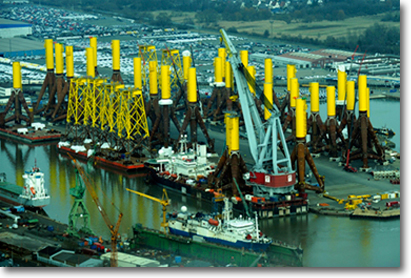
However, Bremen Ports are looking ahead and are investing further in the infrastructure to become a key port for the offshore wind industry. One of Bremen Port’s big “green” port and logistics projects is the Offshore Terminal ABC-Halbinsel in Bremerhaven operated by BLG Logistics Group/WindEnergy Logistics.
This terminal provides an area of 100,000 square meters to handle and store large wind energy components measuring up to 1,000 meters. The 900-meter long quay and a dock with a depth of 10.5 meters allow even high-capacity installation vessels to tie up. With the new Offshore Terminal Bremerhaven (OTB) in the south of the city, another offshore terminal is planned to go into operation by 2016. Up to 160 wind turbines can be pre-assembled, stored, and transhipped at the 25-hectare (63-acre) terminal yearly.
Good connections through the Port of Duisburg
Duisport, located in Germany’s industrial heart of North Rhine Westphalia, is Europe’s largest inland port with a total volume of 63.3 million metric tons handled in 2012. Part of its expansion strategy, the new intermodal transport terminal, logport III that was built by the Duisport Group in Duisburg-Hohenbudberg, will be starting operations in 2013.
Furthermore, this past July, the Port of Duisburg and Port of Antwerp announced that they would be developing the Duisburg-Antwerp axis as one of the most important logistic corridors in Europe.
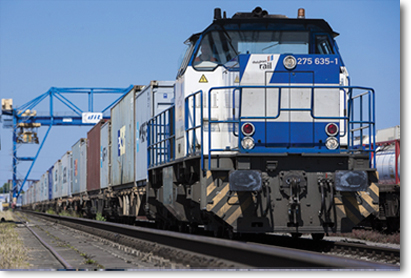
Port officials say they plan to improve the quality of service by reducing transit time in general and provide the Port of Antwerp with better connections through Duisburg as a central hub in the Western European railway system.
To solve the bottleneck for freight trains on the route between Rotterdam and Duisburg, the German federal government, North Rhine-Westphalia, and Deutsche Bahn recently signed a financial agreement for the construction of a third rail line between Emmerich and Oberhausen, an important milestone in the extension of the Betuweroute in Germany.
The duisport Group also successfully tested a new train route to Wilhelmshaven.
The “Wilhelmshaven-Duisport-Shuttle” now connects the DIT-Duisburg Intermodal Terminal on the logport site in Rheinhausen with the Eurogate Container Terminal Wilhelmshaven in the JadeWeserPort.
Article Topics
BVL International News & Resources
Trends and Strategies in Logistics and Supply Chain Management European Logistics 2013: Big Challenges, Bigger Expectations Embracing Global Logistics Complexity to Drive Market AdvantageLatest in Transportation
Baltimore Bridge Collapse: Impact on Freight Navigating Amazon Logistics’ Growth Shakes Up Shipping Industry in 2023 Nissan Channels Tesla With Its Latest Manufacturing Process Why are Diesel Prices Climbing Back Over $4 a Gallon? Luxury Car Brands in Limbo After Chinese Company Violates Labor Laws The Three Biggest Challenges Facing Shippers and Carriers in 2024 Supply Chain Stability Index: “Tremendous Improvement” in 2023 More Transportation












